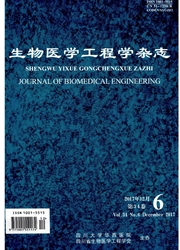

 中文摘要:
中文摘要:
骨组织内部存在两大类液体,一类是血液,一类是间隙流。骨细胞新陈代谢主要依赖于间隙流微环境。在骨组织的微观结构下,骨单元壁中液体的渗流行为是研究的热点。本文的主要目的是考察中央哈弗管的血管脉动对骨单元壁中的间隙流流动行为的影响。本文利用COMSOL Multiphysics软件分别建立了中空的和考虑哈弗管中血管脉动的骨单元多孔弹性力学有限元模型,并对比了轴向载荷下两种模型中骨单元壁中的液体渗流行为。结果表明:当考虑哈弗管中的血管脉动时,骨单元壁中液体的压力会明显增大,而流速几乎没有影响。具体地,骨单元孔隙组织液的压力幅值随着血压脉动幅值的增大而增大,受脉动频率的变化影响不大,而血压脉动幅值及频率对骨单元孔隙组织液的流速基本没有影响。该有限元模型可用来进一步研究非轴对称载荷及微裂缝等复杂应力状态下骨单元的多孔弹性力学行为,并为研究骨的力传导及力-电传导机制提供新方法。
 英文摘要:
英文摘要:
There are two main types of fluid in bone tissue: blood and interstitial fluid. The metabolism of cells mainly relies on the microenvironment of the interstitial fluid. Researches of osteonal fluid seepage behavior based on the microstructure of bone tissue have become a hot point. The aim of the present research work is to assess the effect of blood pressure oscillation on the osteonal interstitial fluid seepage behavior. We established finite element osteon models for a hollow and that considering blood pressure oscillation, respectively, with COMSOL Multiphysics software in order to compare their fluid flow behavior under the axial loading. The results predicted that the interstitial fluid pressure field was enlarged considering the blood pressure oscillation, while the velocity filed changed little. Specifically, the increase of blood pressure oscillatory amplitude could result in the increase of osteonal interstitial fluid pressure, while the blood pressure oscillatory frequency had limited effects on the osteonal pore fluid pressure. Moreover, the blood pressure oscillatory amplitude and frequency had no effect on the osteonal interstitial fluid velocity. The finite element model can be used for the study of the poroelastic behaviors of the osteon under non-axisymmetric loads and microcracks, and can also be a new way to study the mechanism of bone mechanotransduction and electromechanotransduction.
 同期刊论文项目
同期刊论文项目
 同项目期刊论文
同项目期刊论文
 期刊信息
期刊信息
